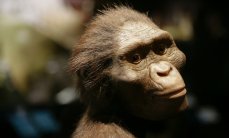Chewbacca was the biggest Australopithecus
Anthropologists found in Tanzania, the footprints of the largest of the currently known species of Australopithecus.
The male, which scientists have named Chewie (Chewie) was 1.65 meters and weighed about 48 pounds.
A description of the findings published in the journal eLife, also it is discussed in the editorial material of the journal Nature.
The tracks were found in the area Laetoli in Northern Tanzania. This area is known for the fact that in 1970-ies a group of anthropologist Marie Leakey found there three footprints of early bipedal hominids: Australopithecus afarensis (Australopithecus afarensis) — the same species to which the famous Lucy).
Traces that became a sensation in the scientific world, was imprinted in the volcanic ashes located just 20 kilometers from the volcano.
In the rain cemented the ash into volcanic tufa, in which are preserved traces.
3.7-million-yr-old footprints of Australopithecus reveal the biggest on record. Researchers named him Chewie https://t.co/43g0wDssdh #StarWars pic.twitter.com/kW96rl5MLp
— Nature News&Comment (@NatureNews) 14 Dec 2016
A new discovery was made almost by accident. Because the original 23-meter track marks are endangered because of erosion and the erosion of tuff, germination, roots of trees, starting with 1990-ies the tracks were most of the time covered with a protective layer of the earth.
Now Laetoli plans to build a Museum and to create a protective coating for the traces. In preparation for the construction of the Museum archaeologist from Tanzania Fidelis Masao (Fidelis Masao) and found a large footprint. He was about 150 metres from the old tracks. In the course of further excavations were found 12 large footprints that make the path length of 32 meters, and another footprint smaller birds.
The length of the traces, the largest of the two individuals, Chewie, is 27 inches, which is approximately 43 feet. Growth Chewie scientists have estimated as 1.65 meters, and weight around 48 kg.
This makes it the largest of all known to date of Australopithecus (Lucy, for example, was a growth of 1.05 meter and weighs about 27 pounds). So the scientists nicknamed him Chewie (Chewie) — affectionate nickname Chewbacca, hero of “Star Wars” two meters tall. As the authors note, the same sounds and the word “leopard” in Swahili: chui.
See also Scientists have established the cause of death was found in Africa of a human ancestor
Scientists have established the cause of death was found in Africa of a human ancestor
The second, smaller Australopithecus, were the increase from the 1.11 to 1.49 meters (since he left only one footprint, to assess its growth more difficult). They both lived about 3,66 million years ago — as well as other individuals who left the prints of his feet in Laetoli.
All the tracks — old and new — “go” in the same direction, and printed in the same layer of ash. It is likely that these prints were left by the individuals belonging to the same social group and going somewhere together.
According to the authors, the large prints had left a big adult male, prints, smaller, two adult females, and the smallest footprints of any two young specimens, or two small females. Of the modern Primate groups with the same social structure live, for example, gorillas: the typical family group they consist of cerebrospinal male, several females and their children. Judging by the traces in Laetoli, the same social structure probably had lived here and the Australopithecines.
See also Scientists have discovered how perceived sounds Australopithecus and paranthropus
Scientists have discovered how perceived sounds Australopithecus and paranthropus
After the discovery of traces of the plans to create a Museum in Laetoli was postponed. While a mile from the place of occurrence planning to build a research laboratory and to continue to seek the optimal location for the construction of the Museum. Meanwhile, all the tracks were again buried under a protective layer of soil.
According to Masao, who discovered traces, the first person he called was anthropologist Richard Leakey — Leakey, the son of Marie (deceased in 1996). Richard Leakey congratulated the archaeologist, adding that he sympathizes with him: “Nature 4 million years of keeping these traces. If you can keep them intact for the next million years?”. The answer to this question Masao was not.
Recently, anthropologists, examining limb bones of Australopithecus Lucy, came to the conclusion that a significant portion of time she spent on the trees — although he was already upright bipedal, and walked also on the ground. Moreover, tree climbing, apparently, was the cause of her death: according to recent reports, she died as a result of falling from a high tree.
Sophia Zolotovskaya